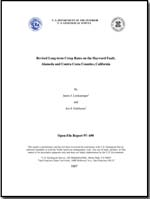Although the Hayward fault is a source of major earthquakes, it also creeps or slips aseismically, and has done so steadily for several decades (certainly since 1921 and probably since 1869). Most of the fault creeps between 3 and 6 mm/yr, except for a 4- to 6-km-long segment near its south end that creeps at about 9 mm/yr. We present results of our recent surveys to recover angles and deflection lines established across the fault in the 1960s and 1970s, but unmonitored since. We have added data from more offset cultural features to the long-term creep rate data set and made substantial improvements to the analytical method used to compute offsets. The revised creep rate values improve our knowledge of spatial and temporal variation along the fault. The more accurate revised data has reduced the estimate of the average creep rate along most of the fault from 5.1 mm/yr to 4.6 mm/yr. Creep rates in the 9 mm/yr section near the south end have remained the same.


